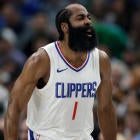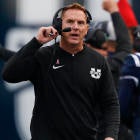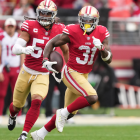Teams fill needs in the draft every year, and oftentimes early-ish selections quickly replace more expensive veterans.
It's not unusual for well-known players to be released after the draft to free up money or simply because of declining play and a new head coach or GM wanting the team to get younger.
Here are the 12 veterans who very well could be on the chopping block after the draft.
Brandon Williams, NT, Ravens
2019 cap hit: $14.1M
Cap savings if released: $6.25M (post June 1 designation)
Possible rookie replacement: Fifth-round pick Daylon Mack
Team need to clear cap space: Moderate
In his prime, Williams had a legitimate argument as the best nose tackle in football. That came sometime in 2014 or 2015. Now 30, the 6-foot-1, 337-pounder is still an upper-level run defender on the inside. However, the Ravens have recently collected comparable nose tackles. Michael Pierce was an undrafted free-agent gem in 2016. He provides pass rush, might even be more disruptive on running plays and is only 26 years old.
Daylon Mack, a 6-1, 335-pound pocket collapser was picked in the fifth round of this year's draft, and while it took until his senior year for him to demonstrate pass-rushing ability -- mostly by way of a devastatingly strong bull rush -- he was a stellar run defender for the vast majority of his four-year stint at Texas A&M.
Baltimore isn't in dire need to clear cap space, but it isn't loaded with space either. While a fifth-round pick isn't a major warning sign to Williams, Mack and Pierce together could conceivably signal Williams may \be on his way out of Baltimore.
LeSean McCoy, RB, Bills
2019 cap hit: $9M
Cap savings if released: $6.4M
Possible rookie replacement: Third-round pick Devin Singletary
Team need to clear cap space: Minimal
I'll start with this: I don't think the Bills are going to cut McCoy. But strictly from positional and financial perspectives, he needs to be listed here. While his statistics dipped in 2018 -- he averaged a career-low 3.2 yards per carry -- the Bills had a bottom-three offensive line and until the late portions of the season couldn't threaten defenses with the pass game. Buffalo had Football Outsiders' third-lowest adjusted line yards -- a metric that assigns responsibility to blockers on running plays.
Anyway, with Singletary -- arguably the most elusive back in the 2019 class -- in the mix, along with free-agent signees Frank Gore and T.J. Yeldon, McCoy, who turns 31 in July, has much more legitimate depth behind him in Buffalo's backfield than he had last season. The $6.4M that could be saved if Shady is let go is enticing, yet the Bills currently have $30.8M in cap space, the sixth-highest figure in football.
But, if McCoy starts slow in training camp and Singletary shines all summer, including the preseason, there'd be a decent likelihood Buffalo releases their former star ball-carrier on cut-down day. Big ifs though. A late August release of Yeldon or even Gore seems more likely despite both being added to Buffalo's roster this offseason.
Gio Bernard, RB, Bengals
2019 cap hit: $4.5M
Cap savings if released: $3.5M
Possible rookie replacement: Sixth-round pick Trayveon Williams, sixth-round pick Rodney Anderson
Team need to clear cap space: Minimal
Bernard has been a reliable air back for the Bengals since the moment he stepped onto the field in 2013. Injuries have hit recently, and he's coming off a season with the second-lowest yards-per-carry average (3.8) and fewest receptions (35) of his NFL career. Like the Bills, the Bengals' offensive line wasn't outstanding last season but did finish in 22nd in adjusted line yards.
Joe Mixon is the unquestioned full-time back in Cincinnati. And two sixth-round selections at running back spot do not automatically spell the end of Bernard's tenure with the team that drafted him in the second-round in 2013. The presence of Williams and Anderson does indicate the Bengals are interested in upgrading the No. 2 running back position.
Had Anderson not gotten injured early in 2018, he likely would've been picked significantly earlier than No. 211 overall. He's a big, fluid back with smooth one-cut ability and plus receiving skills. What is good for Bernard is that Cincinnati, with $22.9M in cap space, isn't in a bad situation financially.
Ryan Griffin, TE, Texans
2019 cap hit: $2.6M
Cap savings if released: $2.6M
Team need to clear cap space: Minimal
Possible rookie replacement: Third-round pick Kahale Warring
Team need to clear cap space: Minimal
As a former sixth-round pick, hats off to Griffin for sticking around for what will be his seventh season, all of which have been spent in Houston. In 2018, for the first time in his pro career, Griffin didn't score a touchdown and has just 37 receptions over the past two seasons.
Houston doubled up on tight ends in the 2018 Draft with Jordan Atkins and Jordan Thomas. Now, Warring is a part of a crowded tight end room. At 6-5 with adequate ability in line as a blocker, smooth movements downfield, and strong hands, the San Diego State product can add a serious threat to Houston's passing game down the seam and be useful on the outside of the offensive line for the run game.
Money is unlikely to be the driving force behind the soon-to-be 30-year-old Griffin being released, as the Texans have $41.3M in cap space, the second-most in the NFL. He should be much more concerned about the numbers game at his position.
Xavier Williams, DT, Chiefs
2019 cap hit: $3.6M
Cap savings if released: $1.8M
Possible rookie replacement: Third-round pick Khalen Saunders
Team need to clear cap space: Moderate
Williams recorded 2.5 sacks while playing 35.9% of the Chiefs defensive snaps last season, but now he has real competition on the inside of Kansas City's front four in Saunders, a penetrating defensive tackle in a nose tackle's body.
With $17.1M in cap space, the Chiefs don't absolutely need to clear space. Saunders has an explosive pass-rushing arsenal and the wide frame plus the low-center-of-gravity strength to anchor in the run game. He'll need to prove he can be more than just a two-down player relatively quickly this summer to usurp Williams on the depth chart, and if Saunders does, Kansas City simply may not need the veteran anymore, especially with 2018 third-rounder Derrick Nnadi -- a run-stopper -- on the roster too.
Daniel Sorensen, S, Chiefs
2019 cap hit: $4.6M
Cap savings if released: $2.6M
Possible rookie replacement: Second-round pick Juan Thornhill
Team need to clear cap space: Moderate
Sorensen played more than 1,000 snaps for the Chiefs in 2017 and logged nearly 500 defensive snaps in seven games in 2018. He simply hasn't been a game-changer at the safety spot, and Kansas City probably just drafted his replacement in Thornhill, a great-sized, freak of an athlete with immense range and awesome run-halting skills from the free safety spot. I still have no idea how he landed in the second round.
Tyrann Mathieu was also signed in free agency, but his strength is his versatility, and he's more of a strong safety, slot cornerback hybrid than anything else.
While the Chiefs' secondary as a whole is a huge question mark heading into the season, Sorensen will need a huge training camp and preseason to stick in Kansas City for what would be his sixth season. Veteran Jordan Lucas and 2018 fourth-rounder Armani Watts fill out the Chiefs' safety room, so depth isn't a big issue.
Kyle Rudolph, TE, Vikings
2019 cap hit: $7.6M
Cap savings if released: $7.6M
Possible rookie replacement: Second-round pick Irv Smith Jr.
Team need to clear cap space: Significant
The NFL's tight end position has become extremely top-heavy, and Rudolph is probably one of the few players at his position who's in his own tier above the run-of-the-mill No. 2 tight ends but clearly below the elite class of Zach Ertz, Travis Kelce and George Kittle. He was targeted 82 times in 2018 and caught 64 balls. His yards-per-reception average? Not great, Bob. Just 9.9 yards, which actually represented an increase from the 9.3 yards per catch he averaged in 2017.
The Vikings currently have just $1.4M in cap space, the lowest figure in the NFL, so they need to create space quickly. Rudolph's potential replacement, Smith Jr., is more of an H-back than a traditional tight end, so that could help his cause to stay in Minnesota.
However, an H-back fits better with the short-passing prowess of Kirk Cousins, who's definitely going to be the Vikings quarterback for at least the next two seasons. Rudolph turns 30 this summer. It'd be a surprise if he's on the Vikings roster in Week 1.
Karl Joseph, S, Raiders
2019 cap hit: $3.7M
Cap savings if released: $2M (via trade)
Possible rookie replacement: First-round pick Johnathan Abram
Team need to clear cap space: Minimal
The Mike Mayock and Jon Gruden led Raiders just drafted a safety prospect in Abram who's basically a clone of Joseph, the club's first-round pick in 2016.
He's had some injury problems and recorded one interception in each of his three NFL seasons. He's somewhat of a throwback player capable of laying the lumber in the run game and struggles with consistency in coverage. It wouldn't make sense for Oakland to cut Joseph because of his dead cap number being more than the money the Raiders would save. In a trade, the team acquiring him would take on his fully guaranteed salary of $2.0M in 2019, meaning Oakland would be on the hook for only $1.7M in dead cap.
Outside of Abram at the safety spot, the Raiders paid big money to free-agent Lamarcus Joyner a few months ago and signed backup Jordan Richards after three years in New England and one with the Falcons. There's not much depth behind those two, which could bode well for Joseph staying with the Raiders for the final year of his rookie contract. Oakland also has $29M in cap space.
Darron Lee, LB, Jets
2019 cap hit: $3.1M
Cap savings if released: $1.8M
Possible rookie replacement: Fifth-round pick Blake Cashman
Team need to clear cap space: Minimal
Lee was a first-round pick in 2016 but his dynamic athleticism has never matched his on-field production as a member with the Jets. He missed four games due to a PED suspended handed down in early December, not exactly the best way to end your third relatively uninspiring season as a pro.
The Jets linebacker room now features big splash free-agent signing C.J Mosley, Avery Williamson, and Cashman, a well-rounded second-level defender with impressive athletic tools and plenty of ability in coverage thanks to how fluidly he moves around the field.
Don't be surprised if New York tries to find a trade partner during the summer, but with $26.4M in cap space, it wouldn't be made for monetary reasons.
Nelson Agholor, WR, Eagles
2019 cap hit: $9.3M
Cap savings if released: $9.3M (via trade)
Possible rookie replacement: Second-round pick JJ Arcega-Whiteside
Team need to clear cap space: Minimal
The only way Agholor isn't playing for the Eagles in 2019 is if Philadelphia trades him. With a fully guaranteed $9.3M salary on his fifth-year option, cutting him would not save any money. A trade would clear that entire salary.
Arcega-Whiteside is a totally different type of receiver than Agholor, but his big body, ability to beat press at the line, and unreal high-pointing skills make him a tremendous deep threat. Also, DeSean Jackson was brought back to Philly this offseason, and obviously, his presence is probably more threatening to Agholor's grip on a roster spot with the Eagles than anything else.
Alshon Jeffery, Arcega-Whiteside, and Jackson are the only legitimate threats at receiver outside of Agholor, but Ertz has to be considered a primary target and 2018 second-round pick Dallas Goedert flashed as a rookie. Strong likelihood there won't be enough targets to go around with Agholor a part of the pass-catching group.
Solomon Thomas, DL, 49ers
2019 cap hit: $7.6M
Cap savings if released: $3M (via post June 1 trade)
Possible rookie replacement: First-round pick Nick Bosa
Team need to clear cap space: Minimal
Thomas would almost have to be a post June 1 trade, which would equate to him saving $3M in 2019 and $4M in 2020 for the 49ers, but then again, San Francisco has $35.4M in cap space, so John Lynch's team is in a position to eat unnecessary dead cap if they get what they feel is great value for Thomas in a trade.
After making a huge step as a pass-rusher in his final season at Stanford sliding up and down the line of scrimmage, with the 49ers Thomas has predominantly aligned on the edge, with disappointing results from the No. 3 overall pick in 2017 Draft.
Could the presence of No. 2 overall selection Nick Bosa push Thomas to defensive tackle, where he could use his twitchiness against slower guards? Possibly. If that's not the plan for him, then maybe a change of scenery is what he needs and San Fran should shop him aggressively.
William Gholston, EDGE, Buccaneers
2019 cap hit: $3.7M
Cap savings if released: $3.7M
Possible rookie replacement: Fourth-round pick Anthony Nelson
Team need to clear cap space: Significant
The Buccaneers have just $1.8M, the second-smallest amount of cap space in the NFL. Gholston's career started decently strong in Tampa Bay, but he's slowly but surely regressed each season. The towering defensive end turns 28 in July, and his likely replacement was picked in the fourth round of this year's draft.
Nelson is 6-7, had a spectacular combine workout and showcased an advanced repertoire of pass-rushing moves during his career at Iowa. He needs to get stronger and maybe even add a little weight to hold up more routinely against the run. He increased his tackle-for-loss and sack figures in each of his three seasons with the Hawkeyes, which culminated in a 13.5 tackle for loss, 9.5 sack campaign in 2018.
Tampa's outside pass rush isn't anything to write home about, but there are enough bodies at the position with Jason Pierre-Paul, Carl Nassib, and Noah Spence on the roster.

















